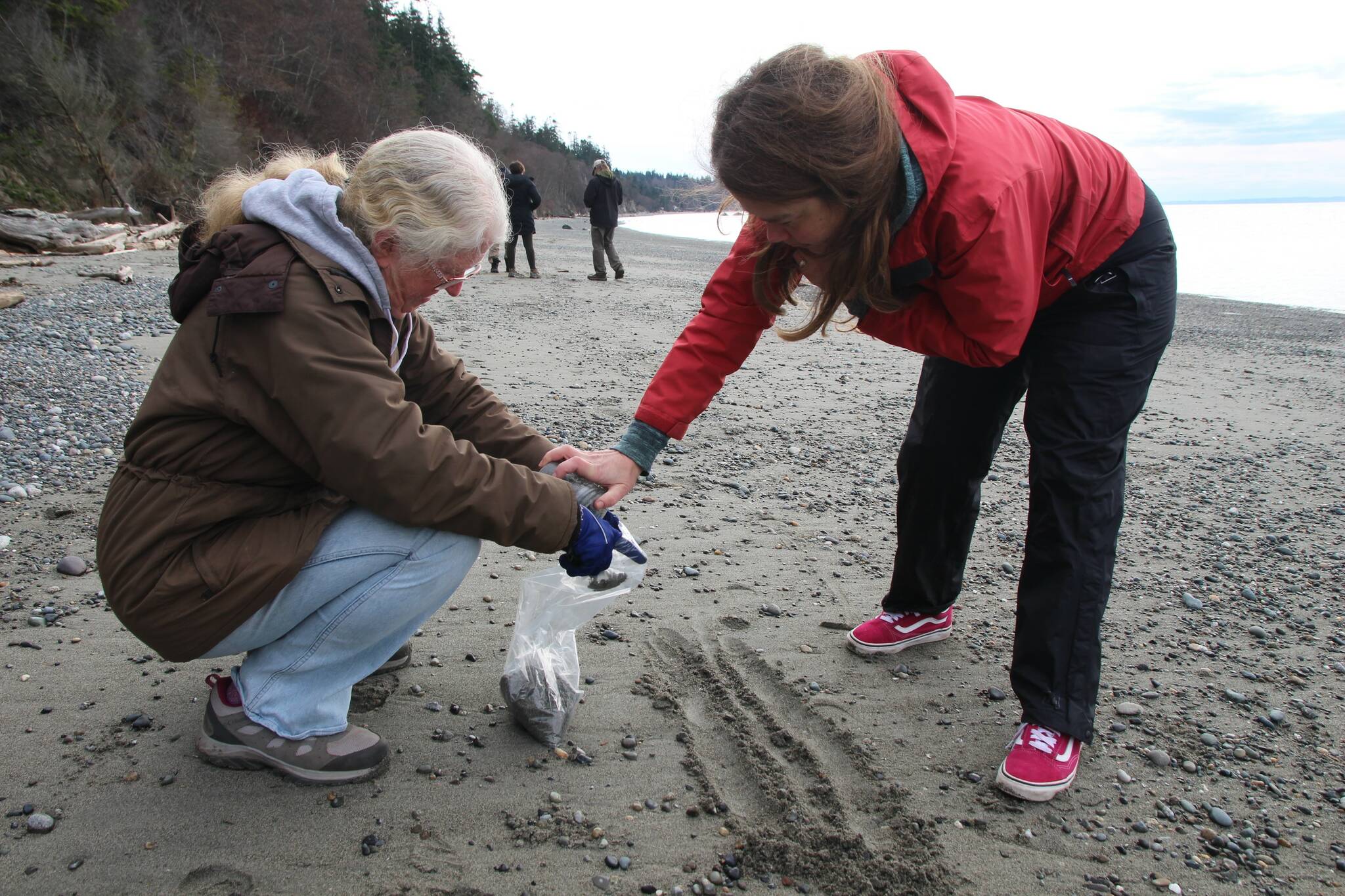On a cold February afternoon, a group of citizen science volunteers scooped sand from a Central Whidbey beach as part of a mission to study and protect forage fish, an underappreciated staple food for sea creatures that is being threatened by shoreline armoring.
Every month since last October, these volunteers have been looking for Pacific sand lance and surf smelt eggs on the beach in front of Keystone Farm and Forest Preserve, the 216-acre parcel that the Whidbey Camano Land Trust acquired in 2022 at the price of $9.1 million.
Now, the Land Trust is ready to give the property a full makeover, removing the beach house and the bulkhead, bringing back native vegetation, renewing the soil, creating trails open to the public and working with the Organic Farm School to operate a sustainable farm on the site.
With the help of volunteers, the Island County Marine Resources Committee has been gathering data to compare spawning activity before and after the restoration of Keystone Preserve and determine the success of the Land Trust’s efforts.
Kirk Larsen was among the four volunteers who, every month, rolls up his sleeves to dig up fish eggs.
“We’re getting a baseline of what it’s like here prior to the restoration,” he said. “So if we don’t find any eggs now and then after restoration we find some, that’s cool, but if we find some now and see what kind of things change afterwards, that’s interesting as well.”
As they walked on the beach, the four volunteers hoped to find at least two tiny Pacific sand lance or surf smelt eggs inside of the three bags they filled with sand and rocks.
A single egg could have washed up on the beach by accident. Two eggs, however, may suggest the fish use the area to lay their eggs during high tide.
Kelly Zupich, who works as the natural resource specialist for Island County, said it’s too soon to predict what changes, if any, they will discover at the site after the property is restored.
“We could see no change, we could see a massive change, we could see an intermediate change,” she said. “It could be all over the place.”
Part of Zupich’s job consists of preparing the samples and sending them to the Washington Department of Fish and Wildlife, where they are examined and added to the bigger picture of forage fish spawning around the Puget Sound. Though she couldn’t provide data, she believes the number of forage fish swimming in the Salish Sea has been declining.
Although forage fish surveys are regularly conducted in five different locations in Island County, including Keystone Preserve, the data is insufficient to reliably estimate how sand lance and surf smelt populations are doing, according to Phillip Dionne, Senior Research Scientist at the Washington Department of Fish and Wildlife.
This is in part because females — which carry thousands of eggs — can spawn in different locations over the course of a few days, Dionne said. Additionally, the great majority of resources goes to the study and protection of larger and more popular predators, like salmon and orcas.
If efforts to protect salmon and orcas don’t include forage fish, Dionne said, then those efforts are likely going to fail. Furthermore, studying forage fish is crucial to explain changes in predator populations.
Both Dionne and Zupich acknowledged that forage fish spawning habitat has been severely impacted by the approximately 54 miles of hard armoring along the shores of Island County, or 25% of the coastline, according to the county’s 2023 Shoreline Armor Survey.
The county is currently in the process of updating its Shoreline Master Program, a document that sets rules on shoreline development. Over the past several months, many residents have come to the commissioners to explain the need for hard armoring to protect waterfront properties from floods and erosion, while others have opposed these structures due to environmental concerns.
Shoreline armoring includes bulkheads (such as the one at Keystone Preserve), seawalls, riprap barricades made of sandbags or cement and any other structure used to temporarily protect a shoreline from erosion.
At Keystone Preserve, the bulkhead is a wall of boulders and concrete.
These barriers are proven to disrupt the exchange of nutrients and debris between aquatic and terrestrial habitats while also causing beaches to erode and disappear, resulting in the loss of spawning habitat, according to the Department of Ecology.
Deirdre Morrison, the property’s caretaker, said the bulkhead separating the property from the beach will be removed, allowing minerals and other deposits to move from the uplands to the wetlands. A softer, natural armor will reduce the impact of waves and slow down the erosion of the beach, potentially benefiting forage fish in search of a place to spawn.
In some areas, Dionne said, armoring has completely destroyed spawning habitats. Where there is spawning occurring, there are often high mortality rates, despite the toughness of the one-millimeter eggs.
Without a safe space to lay their eggs, forage fish populations can’t prosper. With less forage fish, the entire marine food web will suffer.



